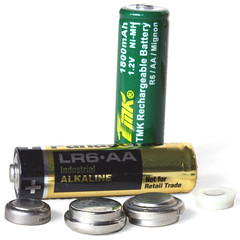Difference between revisions of "Mercury cells"
m (moved battery sizes before section about cameras using PX625) |
m (→References) |
||
| Line 42: | Line 42: | ||
*[http://data.energizer.com/ Energizer Battery Online Data] | *[http://data.energizer.com/ Energizer Battery Online Data] | ||
*[http://www.px625.ru/index.html Russian mercury px625 battery] Seller of PX625 mercury batteries. | *[http://www.px625.ru/index.html Russian mercury px625 battery] Seller of PX625 mercury batteries. | ||
| + | |||
| + | ==Notes== | ||
| + | <references/> | ||
==References== | ==References== | ||
Revision as of 13:05, 6 February 2023
Mercury cells (also referred to as mercury batteries) are batteries with a mercury oxide electrode. Mercury batteries were discovered in the 19th century, and a practical method to make small button batteries was discovered by Ruben and Mallory.[1] These type of battery use the reaction between mercuric oxide and zinc electrodes in an alkaline electrolyte. The biggest advantage of these batteries is that the voltage during discharge remains practically constant at 1.35 volts.
After WWII these batteries were very popular, but in the 1970s, and due to the toxicity of Mercury they were banned in most countries. In the 21st century, manufacture, transport or sale of these batteries is banned or restricted nearly worldwide, due to the metal's toxicity; although some are still made in Russia. Before such bans, many cameras and lightmeters were designed to use them. Because mercury batteries produced a constant and reliable voltage, these devices were built without voltage regulation circuitry. Use of other kinds of batteries, that have different discharge voltages over time, without regulation circuitry may lead to inaccurate meter readings and therefore incorrect exposures.
Contents
Cell names and sizes

|
| 386, PX625 (x2), PX400 mercury button cells compared to AA batteries image by AWCam (Image rights) |
Mercury batteries came in number of different sizes including the 32, 400, 625, 640, 675 and the like. Most of the mercury batteries are a single electrolytic cell - usually small and circular. However, the 32 is a set of 4 stacked 640 cells. The greatest number of cameras, finders and light meters were designed for the PX625.
| Common number | Alternative names | Diameter (mm) | Height (mm) | Weight (g) |
|---|---|---|---|---|
| 625 | 1124MP, MR9, PX625, PX13, EPX625, RPX625, KX625, HD625, PN625, RM625, 625, H1560, H-D, MR9 | 15.6 | 6.05 | 4.5 |
| 675 | 1128MP, MR44, PX675, HD675, KX675, RPX675, H-C | 11.6 | 5.35 | 2.6 |
| 400 | 1116M, MR42, E400N, EPX400, KX400, PM400R, PX400, RM400, T400N, V400PX | 11.6 | 3.6 | 1.4 |
| 640 | 1105M, NR52 | 16 | 11.2 | 8 |
| 32 | 1404M, 4NR52, PX32, E164, TR164, 4NR52, 1404M. HM-4N, V164PX, PX32A, PX32B | 17 | 44.5 | 36 |
Devices requiring a PX625 battery
Many cameras and lightmeters where designed for and require a 625 mercury cell (see a list of cameras and list of exposure meters). Some cameras and exposure meters were designed for 625 sized cells but include voltage regulation circuitry and thus do not require a PX625 to function properly (list of devices).
External links
- Suggestions from Rick Oleson (based on ideas from Leon Schoenfeld) to make classic cameras give acceptable meter readings using zinc-air hearing aid batteries.
- The mercury cell problem and its solutions (PDF file) by F. de Gruijter. Also discusses PX675 and other mercury batteries.
- The mercury oxide battery problem, at Konica SLR system, providing information about the PX625 and PX675 battery that is not specific to Konica models
- Quirks of using zinc-air hearing aid batteries to replace mercury cells part 1 and part 2 from Silverbased (Archived)
- Energizer Battery Online Data
- Russian mercury px625 battery Seller of PX625 mercury batteries.
Notes
- ↑ Samuel Ruben: Inventor, Scholar, and Benefactor Electrochemical Society Journal Fall 2006
References
Popular Photography, October 1993, p. 130; January 1994, p. 144; September 1994, p. 144; and August 1995, p. 66.